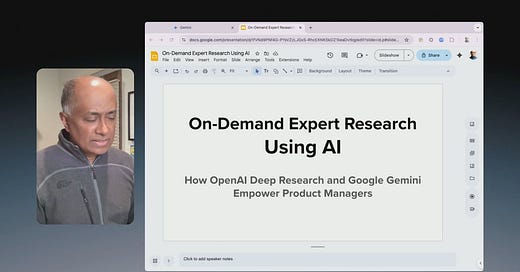Generative‑AI “agent” features have quietly crossed a milestone: they can now do the tedious legwork of market and product research for you, then hand back a fully cited report—often in less time than it takes to book a briefing with a human analyst. OpenAI’s Deep Research and Google’s Gemini Deep Research are leading the charge, giving product managers consultant‑level support at the click of a prompt.
What exactly is “Deep Research”?
OpenAI Deep Research (released Feb 2025) is an agentic mode inside ChatGPT that “finds, analyzes, and synthesizes hundreds of online sources” and delivers a structured report with inline citations. It can run for 5–30 minutes, pivot as it uncovers new information, and attach visualizations or spreadsheets you supply for context.
Gemini Deep Research (rolled out globally in Mar 2025) automatically plans a multi‑step research strategy, browses “up to hundreds of websites,” reasons over the findings, and produces a multi‑page report or an audio overview. It takes advantage of Gemini 2.0’s long 1 million‑token context window for truly deep dives.
Why product managers should care
Competitive tear-downs in hours, not days – Ask either system to map features, pricing, and positioning for every player in a niche market and get a citation‑rich matrix you can drop straight into slides.
Faster diligence on vendors or M&A targets – Paste a funding history PDF, prompt for red‑flag analysis, and receive a consolidated risk report.
Voice‑of‑customer synthesis at scale – Feed community threads or app‑store reviews and get theme clustering, sentiment heatmaps, and design‑informed recommendations.
Reg‑intel on new territories – Let the agent crawl government sites, legal commentaries, and recent case law, then highlight compliance gaps and required mitigation steps.
Instant opportunity sizing – Combine public datasets, analyst forecasts, and macro indicators to build a TAM/SAM model that’s spreadsheet‑ready.
Consultant‑level assistance, 24 × 7
Both Deep Research agents chain multiple tools—web search, long‑context reasoning, and in OpenAI’s case, Python code execution—so the output often resembles a boutique consultant’s deliverable: narrative, data tables, charts, and source appendix. Product managers can iterate live: “Add a SWOT on the top three vendors” or “Re‑rank by ARR and churn.” Because every claim is linked to its origin, you keep audit-ability without the grind.
Getting the most value
Step Practical tip 1. Frame the brief Be explicit: objective, scope, deliverables, success criteria. 2. Attach context Upload docs, spreadsheets, personas; link prior chat threads. 3. Specify format Tables, slide outlines, CSV, or “executive summary ≤200 words.” 4. Iterate Use threaded follow‑ups: refine segments, add benchmarks, stress‑test assumptions. 5. Cross‑check Spot‑check citations and, where stakes are high, triangulate with the other agent.
Bottom line
Deep Research from OpenAI and Google Gemini turns every product manager into a one‑person strategy firm: competitive analyst, market researcher, and due‑diligence partner rolled into one. Used thoughtfully—clear prompts, iterative refinement, and human verification—it can reclaim days of work each cycle and let you focus on the higher‑order decisions only you can make.












Share this post